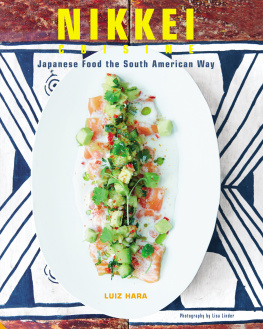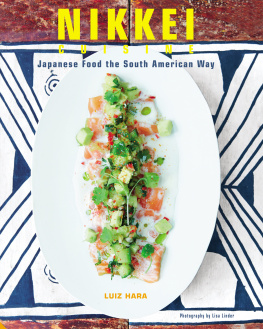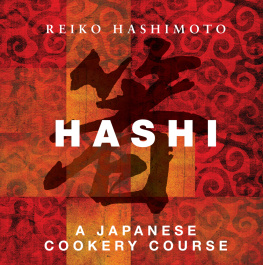For example, take the humble garlic today an everyday ingredient, but once unused and unloved in many Western countries. It was pioneering food writers such as Elizabeth David in the UK and Julia Child in the USA, who opened the eyes and taste buds of their readers in the 1950s. And in most English-speaking countries, whoever cooked with radicchio, pancetta or even balsamic vinegar 30 years ago? It was only through the work of some visionary chefs that these ingredients are in our larders and refrigerators today.
How often have we bought an exotic foreign ingredient for that special recipe only to struggle to think what to do with it beyond cooking that dish, and for it to be sitting in our fridges until it is past its use by date? I think we can all relate to this.
Japanese ingredients all too often baffle home cooks we dont know how to use them except in the recipe at hand. For example, miso paste is the key ingredient in the ubiquitous miso soup, but there is so much more to miso than that. Miso can be used in many different ways to create anything from marinated grilled (broiled) cod to barbecued caramelized pork ribs, and even miso ice cream. Miso is a wondrous fermented ingredient that comes in different colours and textures, and adds a lot of richness and umami to anything it is used with. Miso is now widely available, but how can we make the most of it?
HOW TO USE THIS BOOK
Each chapter of The Japanese Larder concentrates on a set of core Japanese ingredients and their uses in classical Japanese cooking, followed by new recipes created for kitchens beyond Japan. You can use these recipes to create an entire meal, or use one of these dishes alongside some of your own favourites there are no set rules.
Starting with a set of seven core Japanese seasonings, the first chapter investigates why Japanese food is so flavoursome, and how you can achieve the fifth flavour, umami, in your kitchen with just a handful of ingredients.
This is followed by a chapter on dried, fermented and preserved Japanese ingredients that highlights the usefulness of these concentrated foods to bring out complex flavours in your home-cooked dishes.
A third chapter focuses on less familiar Japanese spices, condiments and garnishes, and is an opportunity to bring in new, perhaps undiscovered ingredients into your cooking repertoire.
There is an entire chapter on Japanese rice, noodle and tofu dishes, including recipes on how to make your own noodles, soya milk and tofu from scratch, should you not have access to good shop-bought alternatives, as well as exploring the uses of these ingredients in traditional and modern recipes.
Japanese fruit and vegetables are the focus of the next chapter, and here we consider many native ingredients readily available outside Japan, in a number of savoury and dessert recipes.
In the sixth chapter, we consider Japanese teas and other beverages, including sake, shochu and whisky, and how we can utilize them in some novel desserts and drinks, including ice cream, puddings and easy-to-make cocktails.
Lastly, a chapter on sauces, marinades and garnishes, including traditional and modern recipes created using a number of core Japanese ingredients. These sauces, marinades and garnishes can be used not only in traditional Japanese dishes, but also in your own home creations from recipes in this book and beyond.
I have also included a number of How To Make recipes, which show how to create some important foodstuffs from scratch, including ramen and udon noodles, dashi and tofu, should you wish you to make your own or not have access to good-quality shop-bought alternatives.
All the recipes are made from produce that is readily available in major supermarkets, encouraging cooks the world over to try something new and to expand their cooking repertoire. Plus no specialist equipment or complex techniques are required for the recipes in The Japanese Larder, making them easily achievable at home.
WHATS FOR DINNER TONIGHT?
So, what is for dinner tonight roast duck breasts in clementine teriyaki glaze or grilled lamb cutlets in spicy green miso? Or for a meatless all-in-one meal, why not try the brown butter and miso linguine?
Whatever your preferences, I hope you will find a few recipes in The Japanese Larder to pique your curiosity for Japanese ingredients and bring them into your everyday cooking at home.
JAPANESE KEY SEASONINGS
JAPANESE KEY SEASONINGS
WHAT ARE THE JAPANESE KEY SEASONINGS?
Japanese cooks use seven key ingredients to season their food. These are soy sauce, miso, dashi broth made from konbu (kelp) and katsuobushi (dried bonito fish), sake, mirin and rice vinegar.
In traditional and modern Japanese recipes, you will find at least one, but usually a combination of some (if not all) of these, in different proportions. They are called for in every recipe to achieve the four basic flavours of salt, sweet, bitter and sour, as well as the fifth flavour, umami.
In this chapter, we will explore the use of these seven key Japanese seasonings, in both traditional and newly created recipes ideal for the home cook. You will also see the same seven ingredients appearing in subsequent chapters throughout the book, such is their importance.



















